
Trinity Episcopal Church is a historic church in Mobile, Alabama, United States. It was the first large Gothic Revival church built in Alabama. The building was designed by architects Frank Wills and Henry Dudley.

St. Stephen's Episcopal Church is a historic church located at 196 Brick Church Circle in St. Stephen, South Carolina. Built in the 1760s, it is one of a handful of surviving 18th-century brick parish churches in the state, with a number of architectural features not found on any other of the period. It was declared a National Historic Landmark in 1970.

The Glebe House, built in 1854–1857, is a historic house with an octagon-shaped wing in Arlington County, Virginia. The Northern Virginia Conservation Trust holds a conservation easement to help protect and preserve it. The name of the house comes from the property's history as a glebe, an area of land within an ecclesiastical parish used to support a parish priest. In this case, the glebe was established by the Church of England before the American Revolutionary War.
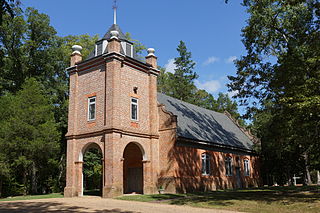
St. Peter's Church is a historic Episcopal church near Talleysville, Virginia, United States. Built in 1703, the church was designated as "The First Church of the First First-Lady" by the Virginia General Assembly in 1960 and added to the National Register of Historic Places in 1969. It was designated a National Historic Landmark on March 2, 2012, as an exceptionally well-preserved colonial-era church.

St. Paul's Church is a historic Episcopal church in Lynchburg, Virginia, United States.

St Mary's Whitechapel is an Episcopal church in Lancaster, Virginia, founded in 1669, and located three miles south of Lively, in Lancaster County, in the Northern Neck. The parish of St Mary's Whitechapel is notable for being the church of Mary Ball Washington, mother of George Washington, during her youth.

St. James Church is a historic Episcopal church building at 86-02 Broadway in the Elmhurst neighborhood of Queens in New York City. It is the city's oldest surviving Anglican building and Church of England mission church. It is also alternatively called the Old St. James Church to distinguish it from the St. James Episcopal Church two blocks away.

St. George's Church is a historic Episcopal Church on VA 178, northeast of the junction with VA 180 in Pungoteague, Accomack County, Virginia. Established in the seventeenth century, the building, erected in 1738, is the oldest house of worship standing on Virginia's Eastern Shore. The church was added to the National Register of Historic Places in 1970.

Christ Church Glendower is the oldest of the historic Episcopal church buildings in St. Anne's Parish, Albemarle County, Virginia near Scottsville. Christ Church Glendower is located in Keene, built of brick in 1831 in the Roman Revival style. It features a full Doric order entablature with pediments at each end containing lunette windows, and is surrounded by a contributing cemetery. The remaining two historic churches in St. Anne's parish are also discussed below.
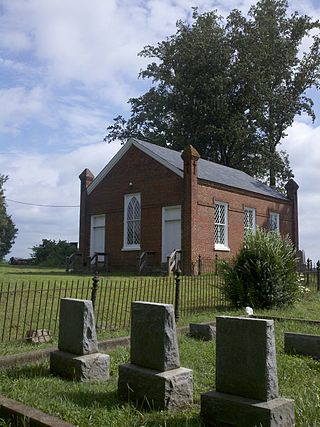
St. John's Church, commonly known as Grub Hill Church, is a historic Episcopalian church in rural Amelia County, in the U.S. state of Virginia. It is located on SR 609 just south of SR 636, between the communities of Amelia Court House and Chula. "Grub Hill" is an obsolete place-name derived from the "Grub Hill" slave quarters of the Tabb family, who donated the land for the construction of an Episcopal church. Grub Hill Church was originally established on the site in the mid-1700s; the current structure was built in 1852, and consists of a one-story gable-roofed brick structure in a vernacular Gothic Revival style.
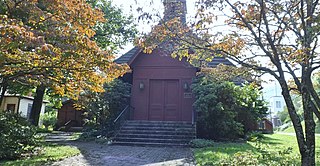
Christ Episcopal Church, also known as Christ Church; Big Stone Gap, is a historic Episcopal church located at 100 Clinton Avenue in Big Stone Gap, Wise County, Virginia. It was built in 1892, and is a cruciform frame church. It is covered with weatherboard and the hipped roof has asphalt shingles. The interior features Gothic style details. Christ Church was organized as a congregation in October 1890 and is one of the oldest in this area.

Abingdon Glebe House is a historic home located near Gloucester, Gloucester County, Virginia. It was built around 1700, and is T-shaped brick structure with one-story hipped roof end pavilions flanking the central portion of the house. The central portion and rear ell are topped by steep gable roofs. It was extensively renovated about 1954. The house and surrounding glebe lands were owned by Abingdon Parish until they were confiscated by legislative act in 1802 as part of the Disestablishment. It was acquired by William Riddick of Gloucester in the 1980s, and was bequeathed to St. James On-the-Glebe Anglican Church, a parish of the Anglican Province of America, after Riddick's death in 2006.

Ware Parish Church is a historic Episcopal church located near Gloucester in Gloucester County, Virginia. One of the oldest surviving parish churches in the Commonwealth, Ware is the only one to retain its original three entrances. Ware Parish is one of the oldest in the state, formed in 1657, three years after Gloucester County's formation. The original building was on the opposite side of the river, the area still being known as "church field". Although a church was built on this site about 1690, the current generally accepted date for the one-story, rectangular brick structure topped by a steeply pitched gable roof is about 1715. Both structures were built during the rectorship of James Clack (1679-1723). Although the inside has been altered considerably, its exterior brickwork is well preserved, and other features include two double guillotine windows in the east end, five windows on each side, and one circular window over the western doorway.
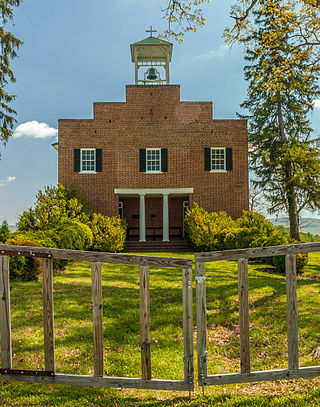
Wickliffe Church is a historic Episcopal church building located in Berryville, Clarke County, Virginia. The church has not been in active use since 1918, except for an annual homecoming service held in August and occasional special events.

Old Chapel is a historic Episcopal church building located near Millwood, Clarke County, Virginia. Old Chapel is now the oldest Episcopal church building still in use west of the Blue Ridge Mountains. It was listed on the National Register of Historic Places in 1973. In 2014, the Chapel Rural Historic District was recognized, and which encompasses both Cunningham parish churches, discussed below, as well as approximately 700 other structures and an area of nearly 10,500 acres.

Vauter's Church, also known as Vauter's Episcopal Church, is a historic Episcopal church located at Loretto, Essex County, Virginia. It was built in 1719, and is a one-story, T-shaped brick building with a gable roof. The south wing was added in 1731. Vauter's is the upper Church of St. Anne's Parish.

Glebe House of St. Anne's Parish is a historic Episcopal glebe house located near Champlain, Essex County, Virginia. It was built about 1730, and is a two-story, three-bay, brick building with a gable roof. It measures about 50 feet long by 20 feet wide and features interior end chimneys.

Fork Church is a historic Episcopal church located near Ashland, Hanover County, Virginia. It was built in 1736, and is a one-story, gable roofed brick building. It measures approximately 34 feet by 74 feet and has walls 22 inches thick. The front facade features a small pedimented porch supported on square brick columns, both probably added in the early-19th century. Also on the property is a contributing church cemetery. Among the more-notable persons who often attended services at Fork Church were Patrick Henry, Dolley Madison, and the novelist Thomas Nelson Page. From 1893 to 1903, Fork Church's rector was the Reverend S. S. Hepburn, grandfather of actress Katharine Hepburn.
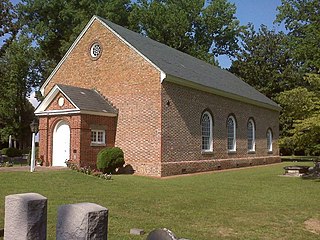
Christ Church is a historic Episcopal church located at Saluda, Middlesex County, Virginia. The present building was constructed in the 1720s, and is a one-story, rectangular brick building with a gable roof. It measures 60 feet by 33 feet, 6 inches.

Hungars Church, also known as Hungars Parish Church, is a historic Episcopal church located at Bridgetown, Northampton County, Virginia. Since 1828, when an additional church was constructed about nine miles away in Eastville, the parish has had two churches.

























